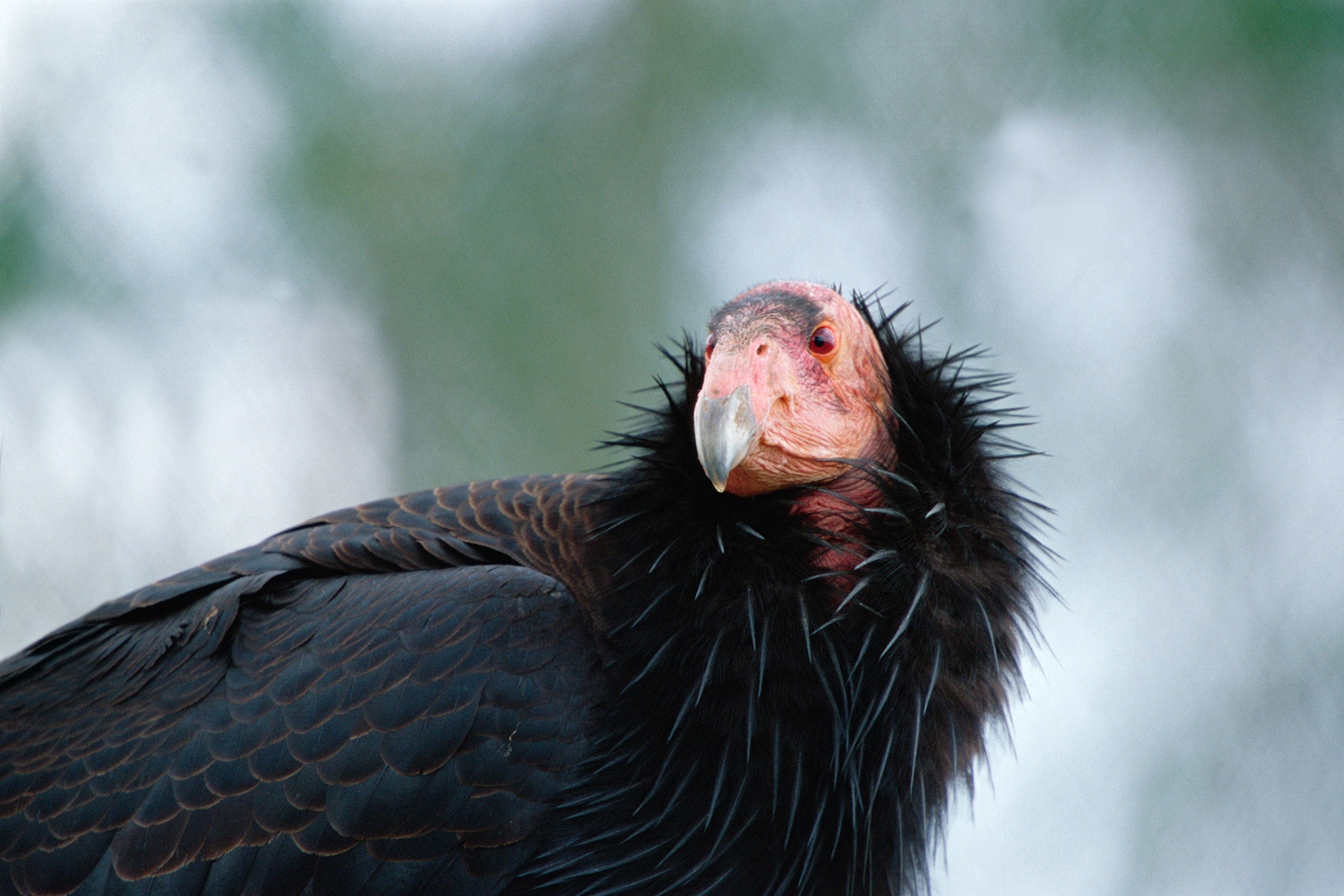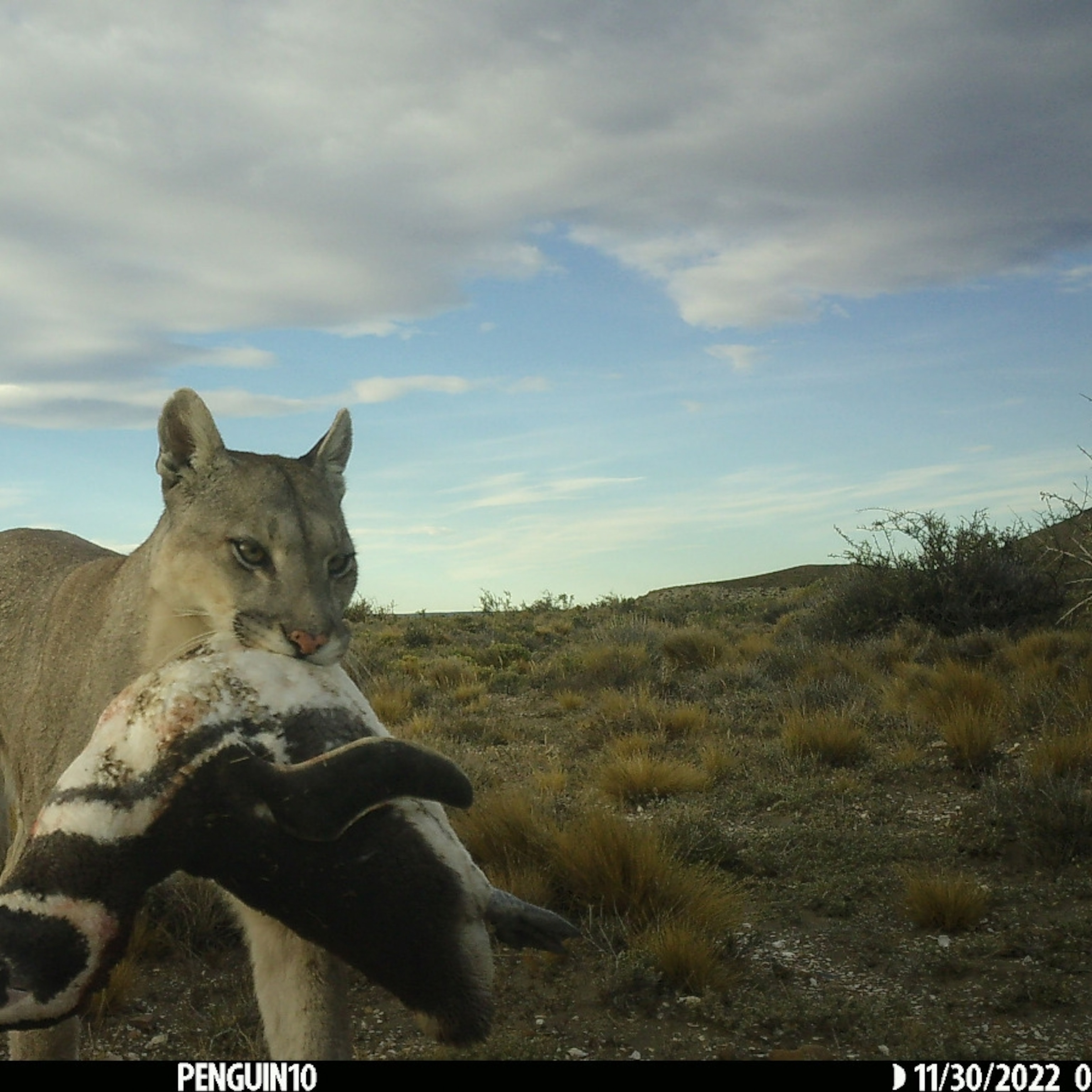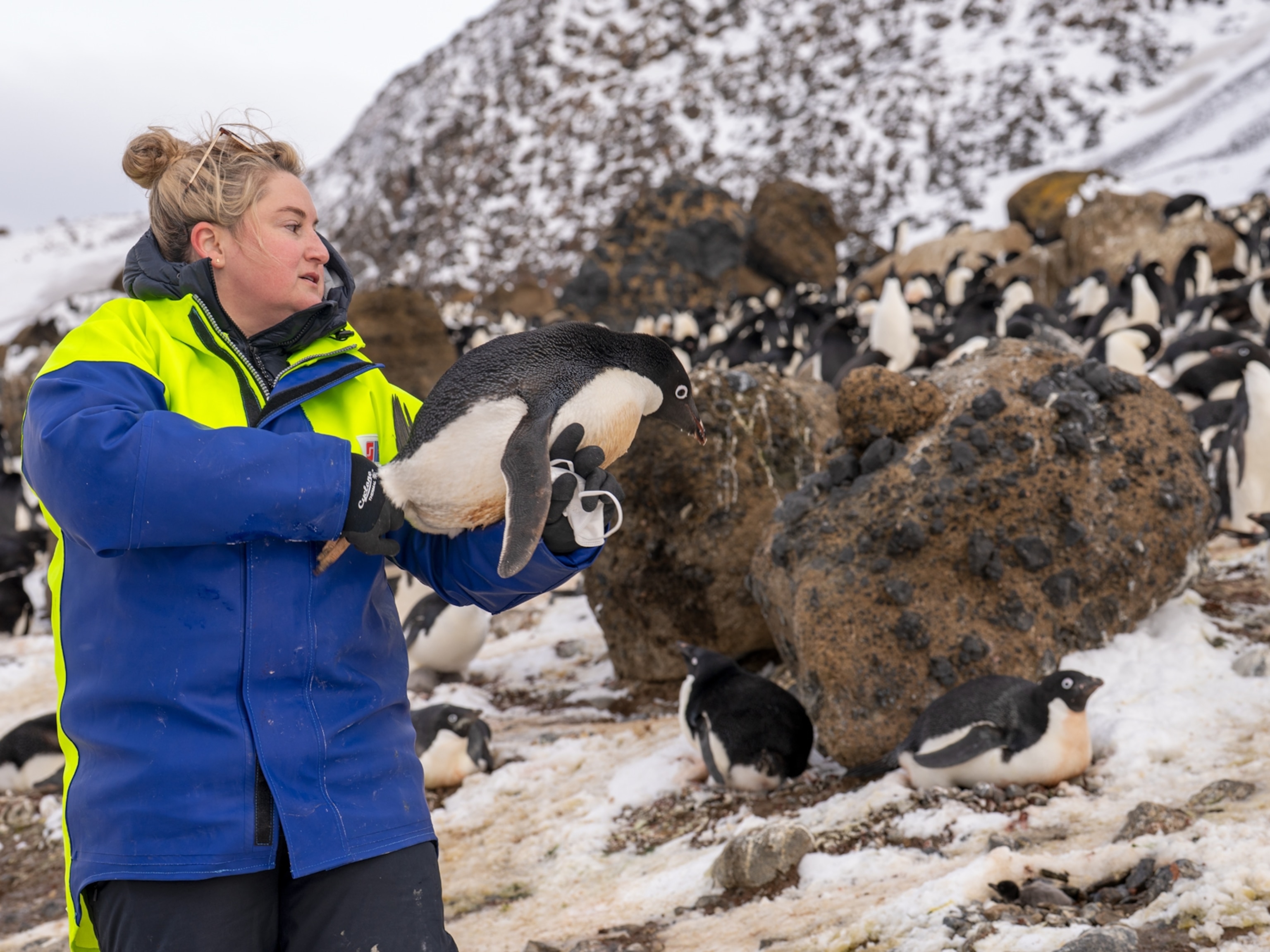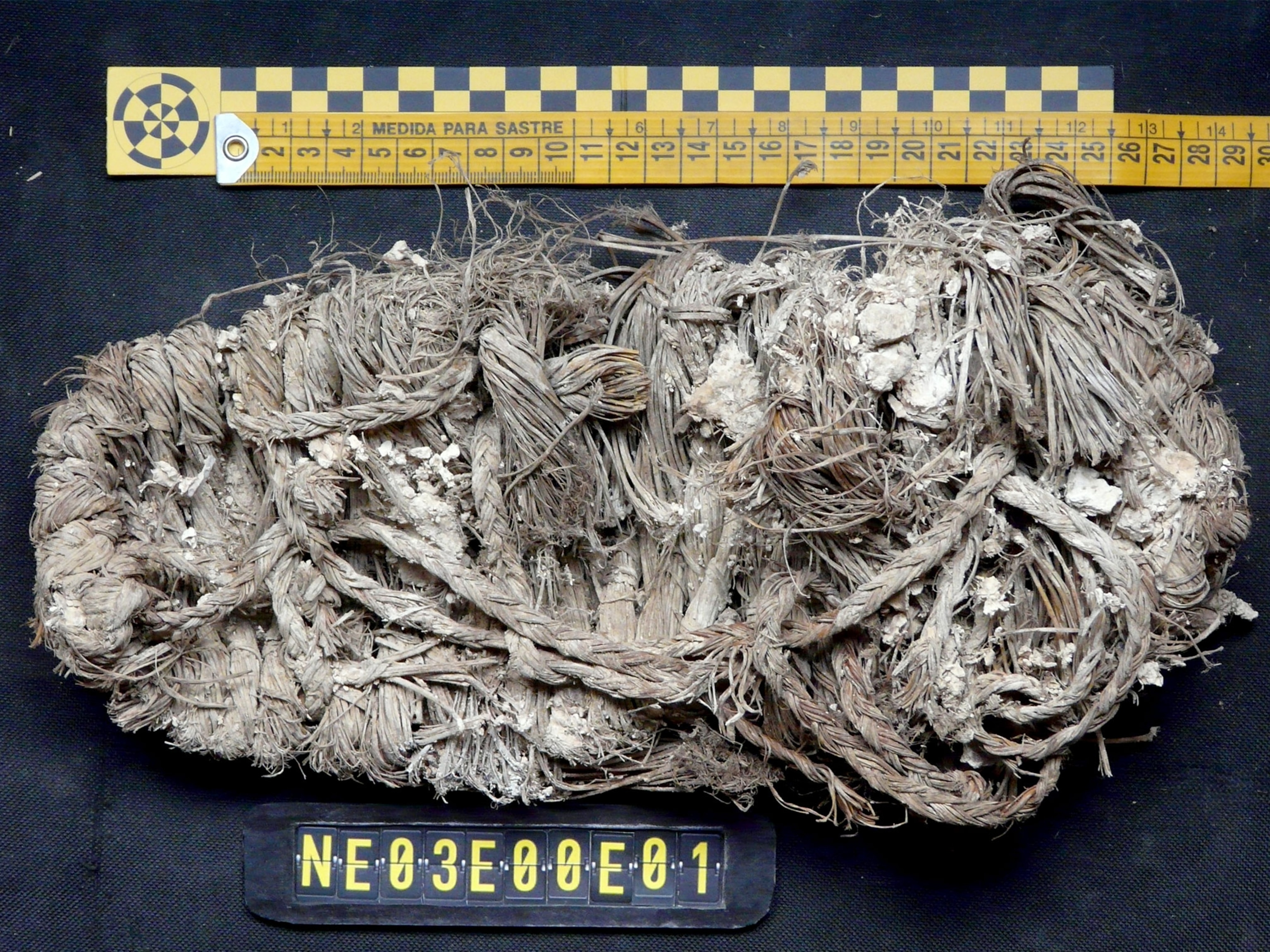
Condors Reach New Milestone of Survival, Thanks to Tree-Climbing Biologists
Condor climbers scramble up redwoods to give a helping hand to North America’s largest bird, a pink-headed giant that has managed to survive since the Pleistocene.
Big Sur, California — High above this rugged coastline, a condor bursts out of a ponderosa pine. With two quick flaps of wings spanning nine-and-a-half feet, the bird slices through the still air. Seconds later another condor flaps out of the tree, circling, chasing, climbing until the pair is soaring overhead in a majestic mid-air pas de deux.
Soon six more condors appear out of nowhere, landing in the pine and vying for a choice perch. Standing on a remote ridge 2,800 feet above the Pacific shore, Joe Burnett, who considers this flock of 84 condors to be his extended family, provides a running commentary: "That male has a bad attitude… Look, he's harassing that juvenile… There's his mate. Their nest is so remote we call it the abyss."
Burnett has been monitoring North America's largest land birds, with their ungainly, 25-pound bodies and wrinkly pink heads, for almost 20 years. For the past decade, every spring, he has climbed into California’s towering redwoods to monitor their eggs, sometimes tracking a condor for several days before he locates its nest.
“These birds are the embodiment of pure wilderness,” he says. “Peering into their world is mysterious – a real privilege.”
Capturing Them to Save Them
Endangered by lost habitat, an egg-damaging pesticide, and lead bullets, California condors, which once inhabited much of the southern half of the United States as well as western Canada and northern Mexico, were on the brink of extinction by the 1980s. State and federal wildlife officials captured the last 22 in the wild so they could launch a breeding program and return them to their natural homes.
Now 289 condors, still a critically endangered species, are flying free in California, Arizona, Utah, and Mexico.
Burnett, a biologist with the nonprofit Ventana Wildlife Society, has been monitoring this coastal flock since the birds were released here, in forested canyons 140 miles south of San Francisco, in 1997. He climbed into a nest for the first time in 2006, when it was discovered 40 feet off the ground in a hollowed-out redwood, the first record of condors nesting in coastal redwoods since 1905.
The egg did not hatch. Wanting to know why, Burnett has since peered into dozens of nests, examining the eggs, weighing newborn chicks, and watching them fledge. The information he collects helps the U.S. Fish and Wildlife Service, the agency responsible for protecting them, monitor condor recovery.
After two decades, the human investment Burnett and other scientists have devoted to condors has helped them finally reach a milestone: Last year, for the first time in nearly half a century, more chicks fledged in the wild than adult wild condors died.
With the 2015 wild chick count at 14 and adult deaths at 12, it’s a precarious gain against perilous odds that include eggshell thinning, lead poisoning and housing developments built in condor habitat. Burnett says that a species smart enough to have survived since the Pleistocene can cope with life today if enough wild places are protected to accommodate them.
The efforts of Burnett and a handful of other condor climbers are helping to increase the number of wild chicks, says Jesse Grantham, former coordinator of the Fish and Wildlife Service's condor recovery program.
Getting them to fledge successfully in the wild is critical to species recovery -- less expensive and more productive in the long run than raising chicks in captivity, he says.
"Some will make it,” Grantham says, “and just possibly they’ll be better able to handle the wild than captive reared chicks, at least in the first year."

Climbing Into “Condor Condos”
On a 100-plus-degree June afternoon, Burnett hikes half a mile down an open slope to check on one of this year's active nests, perched in a dead-topped redwood with a bird's-eye view of the Pacific surf. Wearing a baseball cap to protect his shaved head against the scorching sun, he settles into the long-legged stride of a biologist with decades of field experience. The sunbaked surroundings are a world away from Virginia's lush Blue Ridge Mountains, where he grew up watching red foxes and raptors, and following the nesting patterns of pileated woodpeckers. "I didn't realize I was doing biology as a kid," says Burnett, now 45, with a goatee and black-framed glasses.
He sets up a spotting scope in dried grass on a rounded hillside looking 500 feet down to the nest. The tree is too rickety to climb, he says, but the condor activity clearly signals nesting. Once he begins monitoring the nest, Burnett gets a surprise: not two but three adults tending it, a father and son plus a female. Is this common? That's just one of the questions the condors themselves will answer as their population grows and they reestablish their social patterns. "That book hasn't been written,” says Burnett.
As a first responder, he is on alert for condor crises. Each year in January, when the birds are establishing nests, he heads into the dense vegetation of steep coastal canyons with binoculars and a spotting scope, a radio tracking antennae, lots of water, and a tolerance for poison oak. Once he locates a nest, he maps out a series of climbs to check the fertility of eggs and the health of chicks.
Burnett works with a team that includes a veterinarian. When they gather at the base of a nest tree, the conversation drops to a whisper. Using ropes, harnesses and pulleys, Burnett ascends into the nest. Most are deep in the burned-out centers of redwood trees protected from predators but a short flight to beach foraging. "It's a magical realm perched far off the human map. We never would be coming here unless we found a condor nest," Burnett says.
He makes as many as five climbs a year into each nest, typically four or five of them, scaling heights up to 180 feet to enter a “condor condo.” The parents are protective but not aggressive, he says. “They look at you as if asking ‘why are you here?’ ” Sometimes they block access to their chicks, a passive protection that forces Burnett to come back another day.
The first task is making sure the embryo is alive. Burnett waxes poetic about "these precious glowing orbs – signs of recovery of a species we almost lost." When an egg is not viable he replaces it with a fiberglass one, custom made to the exact size, weight, and color by a volunteer Hollywood special effects prop builder. Later Burnett will swap the dummy for a captive-laid egg that will hatch in the wild for the parents to raise as a foster chick. Of the 39 infertile eggs condor climbers have swapped in California, 25 have resulted in chicks that have successfully fledged.
After a chick hatches Burnett will ascend again to check its health. Many a chick has survived after a climber found bottle caps and other trash in its crop, lowered it on pulleys in a modified rubber trashcan, and sent it in for overnight surgery.
"Every additional chick raised in the wild means we’re that much closer to establishing a sustainable flock," says Kelly Sorenson, Ventana Wildlife's executive director.
Identifying the Culprits
All this egg swapping has helped identify a significant cause of nest failure: eggshell thinning. Analyzing the shells of several damaged eggs, Burnett found high levels of residue from the pesticide DDT, which was banned in the United States in 1972 after it nearly wiped out bald eagles, brown pelicans, and other birds.
In a study published in 2013, Burnett attributed condors’ eggshell thinning to their feasting on the carcasses of sea lions, which accumulate DDT that was dumped into the ocean off Los Angeles for more than 20 years ending in 1971.
Lead poisoning is a continuing problem, too. Nine out of ten condors have elevated lead levels, and nearly half of those tested need to undergo chelation, a procedure to remove heavy metals, according to Myra Finkelstein, an environmental toxicologist at University of California, Santa Cruz. The primary source is ammunition in the carrion that condors ingest.
Her recent analysis of lead exposure in feathers found the species will continue to need intensive care well into the future. Finkelstein has concluded that condors are chronically lead poisoned.
Despite the $5 million-a-year condor recovery program, “this species is not on a trajectory to a self-sustaining population,” she says.
The poisoning of condors was the primary motivation for state legislation banning lead ammunition throughout California. Outlawed first in condor country, it will be banned statewide by 2019. So far condors’ lead levels have not dropped, says Eric Davis, condor coordinator for the U.S. Fish and Wildlife Service.
Heading North
Within a decade condors may extend their range to the forests of the Pacific Northwest, where they have not been seen in at least a century.
The National Park Service is working with the Yurok Tribe, which reveres the bird as a sacred animal, to reintroduce the bird to its ancestral lands adjoining Redwood National Park, in California’s northwest corner. Lewis and Clark saw condors on their journey west in the early 19th Century, so condors used to inhabit the mouth of the Columbia River, Davis says. How these giant birds will fare in a completely wooded environment is part of an evaluation expected to start later this year. Release of birds would not begin until at least 2019.
Burnett views the extension of condor habit from Southern California and the central California coast to the Pacific Northwest as a logical expansion of their natural range. He says condors are adapters, wired for millennia to find a niche in the landscape. Despite the intensity of the human care they are provided, most of the birds are doing fine without it most of the time, Burnett says. "They breed on their own, they nest and they forage on their own."
Many biologists doubt condors will achieve self-sufficiency in their lifetimes, but Burnett is more optimistic. As lead and DDE levels subside, the species could reach that goal within five to 10 years, he says.
Although that would put Burnett out of a job, he looks forward to a time when he would no longer have to climb into their nests and identify every condor in the flock by sight. It would finally mean condors are truly wild and free. "I can't wait to look up and not know who that bird is,” he says.







